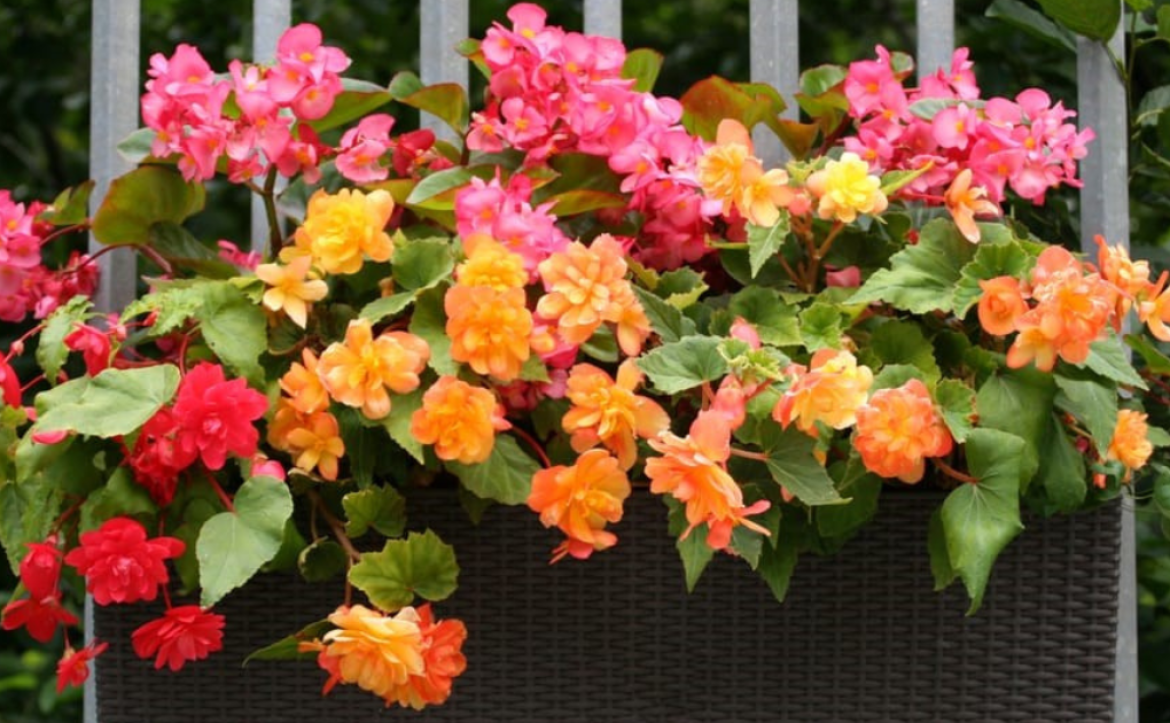
Table of contents
Introduction
Getting to Know Begonia
The Diverse World of Begonias
Caring for Begonias: Essentials
Exploring Begonia Types and Varieties
Maintenance Tips: Pruning and Propagation
Potting and Repotting Begonias
Combatting Pests and Diseases
Overwintering Begonias
Encouraging Blooms: Tips and Tricks
Troubleshooting Common Growing Problems
FAQ
Jurnal Biologi Tropis: Identification of Pests and Diseases on Begonia Plants (Begonia sp) in Sewu Kembang Tourism Village, Karanganyar
Introduction
Begonia plants can generally maintain their color and beauty for a long time with low maintenance. Although these plants are tropical, they thrive in cool climates, growing well in partial shade with little sunlight. As a result, they play a very effective role in interior decoration and in enhancing garden spaces. Due to the unique beauty of their colorful flowers and leaves, landscapers often grow them in outdoor containers, such as hanging baskets or clay pots on balconies, which attract the attention of onlookers.
Getting to Know Begonia
Botanical name: Begonia
Plant type: Tropical evergreen, annual
Sun exposure: Partial sun to shade
Soil type: Moist, rich, slightly acidic
Soil pH: 5.7 – 6.2
Bloom time: Seasonal
Flower color: Pink, red, white, yellow, orange
Hardiness zones: 9-10 (USDA), some varieties 6-9
Native areas: South and Central America, Africa, South Asia
The Diverse World of Begonias
Begonia (Begoniaceae) is a large group of angiosperms, comprising one of the largest genera of flowering plants. With approximately 2,002 species of perennial plants, Begonia is widely cultivated. Some species are grown indoors as ornamental houseplants in winter and outdoors in summer for their brightly colored flowers, which feature sepals but no petals. Generally, begonias require a well-drained growing medium that maintains consistent moisture levels without becoming overly wet or dry.
.
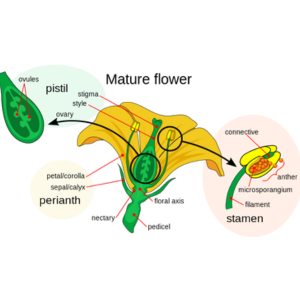
Sepals
Caring for Begonias: Essentials
Three essentials for begonias:
Normal sunlight or partial shade.
Provide regular watering.
Liquid soil mixed with organic matter that drains well.
Light:
The tuber hybrida group comprises violet cultivars that thrive in moderate sunlight or partial shade. Other begonia varieties do well indoors with indirect light or outdoors in partial shade. Extreme temperatures can damage petals and burn leaves, while insufficient shade disrupts photosynthesis and causes leaf death.
Soil:
Purple begonias prefer soil with a pH between 5.5 and 6.5, indicating a preference for acidic soil. Rich organic soil promotes growth, requiring good drainage. Measures taken for Streptocarpus sect, such as African violets, apply similarly to violet begonias due to their similar growth requirements.
Water:
Water begonias sparingly, ensuring the topsoil remains slightly loose to prevent waterlogging, which can lead to overwatering and root rot.
Temperature and Humidity:
Begonia plants grow best indoors at a temperature of 18 to 22 degrees Celsius (65 to 70 degrees Fahrenheit). As the plants are tropical, they cool off in the late summer evenings, but when the weather is cool during the day and night, the plants begin to go dormant. These plants survive best when the humidity is below 50%. In homes that tend to have dry air from the heat of winter, a humidifier can be used to keep plants dry and hydrated.
Fertilizer:
Different violet plants require different types and proportions of fertilizers. For rhizomatous (a rhizome from Ancient Greek “mass of roots”) seedlings of begonias planted indoors, water : fertilizer = 1:2 or 1:4 ratio applied to moist soil during spring will produce more flowers. On the other hand For tuberous begonias (5-1-1) fertilizer (such as fish emulsion) can be applied twice a month. Again, for hardy begonias, apply sparingly with some composted manure as the leaves will drop off and the plants will not survive.
Exploring Begonia Types and Varieties
A container adorned with beautiful begonia flower species will prompt all visitors to think just like this. If every garden is designed with a variety of species, it will become a place of heavenly tranquility. Today, I will share with you how to grow seedlings of different varieties of begonia flowers in containers and how to arrange them on balconies, in gardens, and along small pathways. Decorating any space, whether small or large, with different flowers is what we call garden theme design. Let’s delve deeper into the topic today.
Different varieties of begonia flowers have captivated us with their distinct characteristics. Here, I will discuss several species of begonia flowers and delve into the details of begonia flower cultivation methods.
Begonia Types
Tuberous Begonias:
The variety of begonia flowers that we see now originates from the species Begonia x tuberhybrida. Plants of this species do not grow from fibrous roots, but from tubers. They have become popular with audiences due to their long-lasting brilliance. Each plant has both male and female flowers, but the male flowers are typically more beautiful.
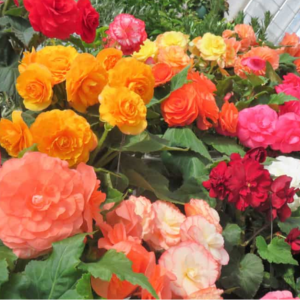
Planting tuberous begonia flowers in baskets or containers allows them to grow and form a flower bed. Thus, we can use these containers or baskets to decorate inside the house, on the balcony, or along small pathways. Begonia plants can grow in full sun heat or partial shade. Usually, they begin blooming in summer and continue until autumn. To care for them, water them regularly, especially during dry weather, and provide potassium fertilizer once a week to encourage more blooms. Be careful that water does not fall on the leaves.
As gardeners, we often purchase new seedlings every spring, but these begonia flowers can survive the winter with some care. Before the first frost, remove the tuberous begonia tubers and store them in moist soil until spring. Water them occasionally to encourage growth and eventual flowering.
Hardy Begonias:
If you have a shady spot that you want to draw attention to, plant hardy begonias. These plants thrive in low light, and their bright colors blend well with shaded areas.
You can buy small seedlings of hardy begonias from horticulture or nurseries, although they are typically propagated from tubers. In regions with mild winters, you can plant tubers in the ground year-round. Then add some mulch, such as tree bark, for extra insulation.
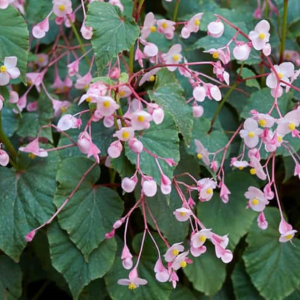
In areas that receive snow, you can remove the tubers from the soil when the leaves begin to turn yellow in the fall. Then, lift the plants and store the tubers in moist soil at 35 to 40 degrees Fahrenheit.
Place each tuber in a four- to six-inch pot indoors at 50 degrees F in early spring, and plant them in the ground after the frost.
Wax Begonias:
also known as Begonia semperflorens, produce beautiful red, white, and pink flowers in the shade all summer.
These are usually annual plants, but we have found that they last for years if properly cared for.
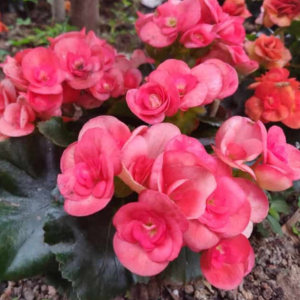
Like other varieties, wax begonias can be grown in full sun or partial shade. Regular watering and the application of fertilizers high in potassium will encourage their growth. They can be grown from either seed or cuttings, but cuttings are considered a common method if you want to produce double flowers.
Cane Begonias:
If you’re looking for a plant with spectacular leaves for your indoor environment, then you can choose cane begonias. Since they grow over 10 feet tall, they make great focal points when placed on shelves or windowsills. Trim them regularly to reduce excess height, and provide extra support to encourage vertical growth.
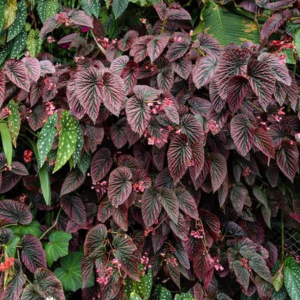
While you may see very small flowers on cane begonias in some cases, the main attraction is their leaves. These leaves display different colors and streaks, and when combined with clusters of orange, red, pink, or white flowers, they create a beautiful display. Provide them with low light and use various household waste items such as eggshells, tea leaves, and vegetable scraps as fertilizer, along with nitrogenous fertilizers, to promote leaf growth.
There are several subcategories of this plant, including “angel wing begonias,” “dragon wing begonias,” and superba begonias, named for the distinctive shape of their leaves.
Begonia Varieties
Begonia ‘Illumination Apricot’:
“Illumination Apricot” is one of those beautiful and bright flowers in the warm shade of apricot. It is included in the Illumination series. The plant features large double blooms, pendulous stems, and oval leaves. Its flowers are usually yellow, pink, orange, white, or red. Some cultivars have flowers that feature deep rose or red colors.
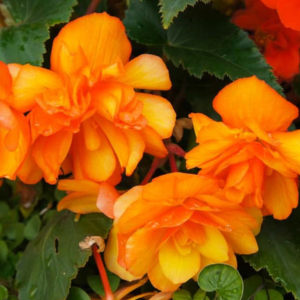
These plants last all summer and into fall. They are perennial plants and grow in height from 4 to 20 inches in about two years.
Begonia ‘Splendida Alifra’:
‘Splendida Alifra’ is another species of begonia that makes an attractive plant for hanging on a vine or in a hanging basket. More than 2 pink flowers together with yellow stamens grow beautifully in the shade. We see the flowers in July and they continue to grow until the first frost. They grow fairly quickly and spread to about 1.5 feet, filling the basket completely.
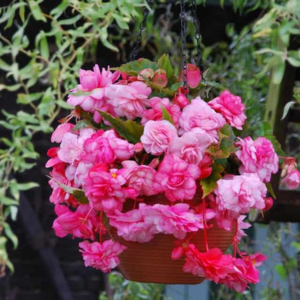
If you can protect it during frosts, it will add beauty to your garden next year. If planting these plants in garden beds, lift the tubers and plant in a layer of compost until the weather warms.
Begonia ‘Mother’s Day’:
“Mother’s Day” is very special to us, and the plant displays its beautiful flowers in this month, which continue to bloom until the first frost. So it is an exceptional and blooming “Mother’s Day” begonia. The center of the flower is light white, and the petals have a pale pink flush that deepens. Another feature is that the arch runs over the stem.
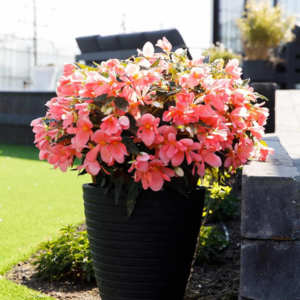
Deadhead this plant regularly and keep it in partial shade with organic fertilizer for abundant flowering. At about six inches tall and 1.5 feet wide, this plant is quite small. You can place it as a container plant in a hanging basket on the porch or balcony, or it is more decorative in a pot, basket, or tub on the side of the hall, balcony, or narrow street.
Begonia ‘Million Kisses’ ‘Honeymoon’:
A variety of semi-successive begonias are included in the “Million Kiss” series. A ‘Honeymoon’ begonia is one with profuse blooms that contrast with the green foliage.
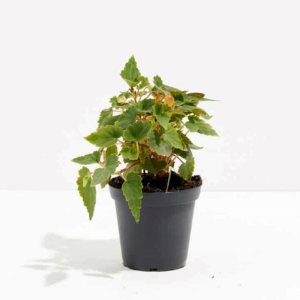
Plants of this series are well adapted to both high temperatures and drought environments. They do not require pruning and grow with little care. Adaptable to small spaces and both climates, these plants are ideal for adding beauty to troughs, tubs, window boxes, or hanging baskets.
Begonia ‘Truffle Cream’:
This is another good choice for a hanging basket, with the ability to trail tendrils up to a foot long. Feed it liberally and keep the soil moist in summer, and you’ll be rewarded with globes of pretty pink flowers. The petals are slightly darker on the underside, which makes a hanging basket an ideal planting location. When the sun shines through the petals, you will see contrasting colors.
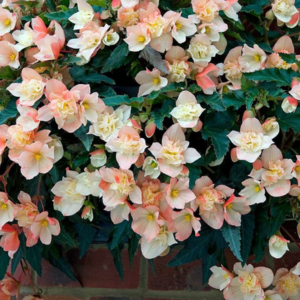
The plant blooms throughout the summer months, but it’s an annual, so it won’t come back next year. Beautiful and mind-blowing is the Begonia ‘Truffle Cream’ flower with its unusual shape and surrounding long oval petals. The long and serrated leaves make the flower more attractive, which is more visible to the audience.
Begonia ‘Peardrop’:
The center of these flowers is yellow, and the outer petals are salmon orange, with multiple flowers covered with bright green leaves with silver veins. This flower has become quite attractive due to its own characteristics. Fertilize during the growing season to encourage it to grow so that it can form a mound of dark green leaves around the orange blossoms.
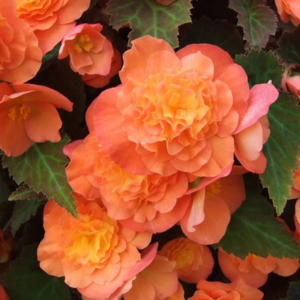
Begonia ‘Peardrop’ flowers first appear in July, and they bloom in abundance for about four months. It was awarded the Royal Horticultural Society’s “People’s Choice” award in 2013 for its long-lasting beauty.
Maintenance Tips: Pruning and Propagation
Pruning:
More or less, almost all plants need pruning as they grow. Therefore, light pruning is required to remove dead or damaged branches or leaves in violet plants.
Propagation:
For propagating Begonia plants, we generally use two methods: leaf cuttings and rhizomes or tubers. So ,you must follow some rules
Keep the leaf cuttings in water with a little sunlight. Plant them in potting soil when shoots form from the leaf cuttings.
Rhizomes and tubers can be placed in moist potting soil and gently pressed. Within a few weeks, you will see new plants growing.
Potting and Repotting Begonias
Begonia plants grow well both indoors and outdoors. However, for outdoor growth, it is better to use a terracotta pot with good drainage. Indoors, a drainage system is usually necessary for successful growth.
When propagating plants from rhizomes or tubers, you must provide ample space for growth. If the plant doesn’t have enough space, its growth will be disrupted. Therefore, it’s important to transplant it into a larger pot when needed. Gently lift the shoots or tubers with your fingers or a slotted spoon and plant them in a pot with fresh soil, then water them liberally.
Combating Pests and Diseases
Begonias are generally not affected by many pests or diseases. However, excessive watering can lead to root rot, stem rot, or powdery mildew. Some pests that can affect them include mealybugs, spider mites, snails, and slugs. You can remove them easily by hand, and if necessary, you can also use pesticides.
Overwintering Begonias
If outside temperatures drop below 15 degrees Celsius (60 degrees Fahrenheit), plants should be brought indoors.
Encouraging Blooms: Tips and Tricks
For maximum flowering and blooming, it’s important to fertilize the plant regularly, but the fertilizer must be diluted, liquid, and organic. Never apply fertilizer to dry soil. Deadheading regularly will result in more flowers.
Troubleshooting Common Growing Problems
What to do if the flowers fall off?
When the violet plant is exposed to too much sunlight, the flowers will dry up and turn brown. At this time, if your plant is in a container, move it to low light or partial shade. If it is planted in the garden, provide shade under a tree.
What to do if the plant is not blooming fully?
There are several reasons why flowers may not bloom fully. Some of the reasons include insufficient watering, excessive sunlight, and lack of drainage. If these problems are addressed, the flowers will bloom properly.
FAQ
Do begonias prefer sunlight or shade?
Begonia plants thrive in light shade and partial sunlight.
Do begonias come back every year?
Although Begonia is a tropical plant, it thrives in partial shade and survives only in winter in warmer climates. Some exceptions are hardy begonias that can survive in USDA zones 6-9, while others can grow indoors in partial sunlight year-round.
Do begonias spread?
Most begonias do not spread very quickly, except for certain types such as rex begonias. These plants spread a little faster than fibrous or hardy begonias.
Articles:
Here is a short guide that explains common diseases of begonias and practical steps to cure them. You follow these steps.
Jurnal Biologi Tropis: Identification of Pests and Diseases on Begonia Plants (Begonia sp)
Begonia (Begoniaceae) is an angiosperma group of the world’s largest genera, with a distinct leaf asymmetry. Begonias have considerable economic value and some Begonia plants have potential as medicinal plants and vegetables. Pests and diseases are a problem in the development of begonia cultivation. The aim of this study is to identify and identify the types of pests and diseases that attack begonia plants. This study was conducted over 30 days using 10 begonia plant samples. The variables observed were pests and diseases that attack begonia plants. The results of the study revealed 1 disease called nitrogen deficiency and 2 pests namely caterpillars and snails. which damages the leaves
Begonia (Begoniaceae) is a large group of Angiosperms in a group, interesting colors and different flowers.
Begonias of various colors are available as an ornamental plant. Begonia species can also be used as food and medicine. Used Begonias have been used for a long time
As an ornamental plant. This type of begonia has economic value and potential
Medicinal plants. Begonia, not only as an ornamental plant but as a medicinal plant including: treating sore throat, external swelling, inflammation, vomiting blood, late menstruation, irregular menstruation, vaginal discharge, rheumatism.
Hybridization can occur between Begonias. Begonia has produced new varieties that are more attractive, unique and better than its parents.
Begonias also need fertilization regularly so that it grows well. Daily fertilization is recommended once every three months, the type of fertilizer suitable for begonia plants is liquid fertilizer, organic fertilizer.
Types of pests that attack begonias are other snails and caterpillars. Human hands, ie pick up insects and throw them away.
Caterpillar control uses insecticides. Symptoms appear on affected leaves resulting in hollow and unevenly pitted leaves from these pests that feed on begonia plants. Caterpillars / larvae of the order
Lepdoptera and the family Lasiocamidae attack leaves. Hollow leaves and uneven spots on leaf edges are torn with visible uneven bite marks until eventually some leaves are left with only leaf bones. This would be due to disruption of the photosynthesis process which inhibits plant growth. Diseases that often attack begonias cause their leaves to turn yellow and dry. According to
Plants that are nutrient deficient in nitrogen (N) or have symptoms of nitrogen (N) deficiency such as: light green plants, lower leaves yellow, dry until light brown, stems short and flat when nutrient deficiency occurs in advanced growth stages. Where symptoms are indicated by nitrogen deficiency but the plant is dark green, the crown usually forms a root system small (shallow and limited), burning symptoms on the edges of the leaves and the strands in the veins of the leaves followed by tissue death.
Sample Symptoms Pests Diseases Picture
- Leaves dry out some in edge there is yellow spots on leaves Deficiency nitrogen
- Leaves with holes and fringe serrated leaves Caterpillar
- Leaf dry up change color yellow short stem Deficiency nitrogen
- Perforated leaves leaf margins torn apart jagged and there is mucus Snail
- Perforated leaves leaf margins torn apart jagged and there is mucus

- Some edges of the leaves dry up, there are yellow spots on the leaves due to lack of nitrogen
- Some edges of the leaves dry up, there are yellow spots on the leaves due to lack of nitrogen
- Uneven and jagged leaves with holes
- Uneven and jagged leaves with holes
- 10 leaves with pores, mucilaginous sipu
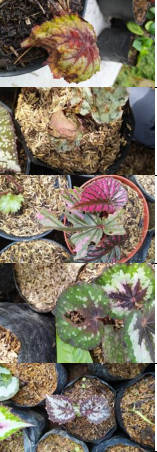
Identification of Pests and Diseases on Begonia Plants (Begonia sp) in Sewu Kembang Tourism Village, Karanganyar
Adinda Mustika Kurnianingtyas1* , Inayah Romita Diani1 , Prayoga Felix Z1 1Biology Education Program, Faculty of Teacher Training and Education, University of Veteran Bangun Nusantara, Sukoharjo, Indonesia
Kurnianingtyas, AM et al., (2022). Jurnal Biologi Tropis, 22 (2): 368 – 373
